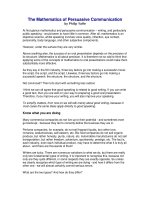Tài liệu The Diet and Cancer Connection ppt
Bạn đang xem bản rút gọn của tài liệu. Xem và tải ngay bản đầy đủ của tài liệu tại đây (339.28 KB, 4 trang )
www.ext.vt.edu
Produced by Communications and Marketing, College of Agriculture and Life Sciences,
Virginia Polytechnic Institute and State University, 2009
Virginia Cooperative Extension programs and employment are open to all, regardless of race, color, national origin, sex, religion,
age, disability, political beliefs, sexual orientation, or marital or family status. An equal opportunity/affirmative action employer.
Issued in furtherance of Cooperative Extension work, Virginia Polytechnic Institute and State University, Virginia State University,
and the U.S. Department of Agriculture cooperating. RIck D. Rudd, Interim Director, Virginia Cooperative Extension, Virginia
Tech, Blacksburg; Alma C. Hobbs, Administrator, 1890 Extension Program, Virginia State, Petersburg.
PUBLICATION 348-141
The Diet and Cancer Connection
Kathleen M. Stadler, Extension Specialist, Human Nutrition and Foods, Virginia Tech
Introduction
One out of every three Americans will be diagnosed with
cancer at some time. Cancer affects three of every four
families.
Cancer is the second leading cause of death in the U.S. Each
year, nearly 500,000 Americans die from cancer. While the
rates for coronary heart attacks and uncontrolled high blood
pressure are declining, certain cancer rates are increasing.
Many people assume that getting cancer is a matter of bad
luck and environmental hazards. But many cancer experts
now believe that lifestyle factors-smoking, diet, stress, sun-
bathing, etc are more important factors than thought pos-
sible a few years ago. Lifestyle factors are involved in most
cancers, with controllable factors estimated to be as high as
80 to 90 percent of all causes. Diet may account for some 35
percent, and smoking another 30 percent.
A critical factor needing much more study is the inuence of
heredity on cancer susceptibility. Some people never develop
cancer despite years of exposure to tobacco, poor diet, alco-
hol, sunlight, etc., while others, unexposed, will get it. Why?
The answer must involve heredity. For some, the genes, with
all their inherited deoxyribonucleic acid (DNA), resist per-
manent damage (mutation) by cancer-causing agents, known
as carcinogens. For unlucky others, a combination of modi-
ed genes and a suitable internal environment results in the
dreaded diagnosis.
Maintaining good nutrition and avoiding tobacco, certain
heavy metals, pesticides, excessive ultraviolet light and
radiation provides a strong defense against many common
cancers. Food with protective nutrients may add many dis-
ease-free years as well as pleasure from good eating.
Researchers believe that everyone harbors initiated cells
that will not become cancerous if they are destroyed or kept
in check by the immune system. In most cases, the body’s
immune system recognizes and destroys these strange,
initiated cells. However, in cancer, the immune system
may become overwhelmed or lose its ability to recognize
the foreign cells, allowing them to escape destruction and
multiply.
A number of agents are known to cause DNA mutations:
ultraviolet light, radiation, certain chemicals such as those
found in tobacco, smog and pesticides, a few viruses and cer-
tain diet-related agents.
Known dietary agents include oxidized fats, nitrates and
nitrites, and chemicals produced during charcoaling, smok-
ing or grilling meat.
Contrary to popular opinion, food additives have few, if
any, cancer-causing properties. New food additives are care-
fully researched before being allowed in food and are safer
than many natural chemicals. Some experts believe there is
much more risk from natural food substances than from food
additives.
In animal studies, two commonly used preservatives, BHA
and BHT, usually protect against cancer, especially if they
are added to the food before the animals are exposed to the
carcinogen. No one knows whether this is true for humans,
but this and other questions need continuing study to ensure
a safe food supply.
Lung Cancer and Diet
Smoking is clearly associated with high death rates from lung
cancer. More women now die from lung cancer than breast
cancer, and women’s lung cancer death rate is expected to
continue rising because of the large number of women who
started smoking after World War II. Men’s rates are fall-
ing as they stop smoking. If smoking trends continue (cur-
rently three or four male smokers for every female), men and
women may develop lung cancer at equal rates by the year
2000.
2
Researchers are still unsure about diet’s role in lung cancer,
but the nutrient most associated with protection is betacaro-
tene, a vitamin A precursor. Bright yellow-orange beta-car-
otene is one of a number of carotenoids that have anticancer
activity even greater than vitamin A. Other possible lung
protectors are foods high in vitamin C, other antioxidant
nutrients and indoles, a natural chemical in vegetables.
These nutrients may protect lung linings but cannot totally
prevent damage. Experts believe that taking vitamin A or
carotene supplements is no substitute for stopping smoking.
Dark green and dark yellow-orange vegetables and yellow
fruits have the most beta-carotene. Vegetables high in caro-
tene are carrots; green and red peppers; leafy greens such as
kale, spinach, and turnip greens; sweet potatoes and winter
squash. Among fruits, mangoes have the most carotenes but
apricots and cantaloupes are also excellent sources. Other
fruits and vegetables contain good amounts of beta-carotene.
Other nutrients, such as vitamins C and E and the mineral
selenium, may offer additional protection.
To reduce your risk for lung cancer, stop smoking and eat
lots of fruits and vegetables, especially those colored deep
yellow and dark green or high in vitamin C.
Gastrointestinal Tract, Prime
Cancer Target
Cancer can develop anywhere along the gastrointestinal
tract, but colon cancer is the most common gastrointestinal
tract cancer in the U.S.
An unbalanced diet, with too much fat and not enough ber
and antioxidants, is the most likely promoter of colon cancer.
For humans, the closest associations between diet and col-
orectal cancer are high fat intake, particularly saturated fat,
and low consumption of vegetables. Some studies link colon
cancer with obesity and high protein intakes, particularly
meat, but this may reect too much meat fat rather than pro-
tein and not enough dietary ber or other plant substances.
While ber may protect the colon lining, the protective fac-
tors may be the associated antioxidants in plant foods, nota-
bly vitamins A and C in fruits and vegetables and the mineral
selenium in grains.
Other natural food chemicals may also be banecial. Ample
intakes of cruciferous vegetables-those belonging to the
Brassica genus-are associated with lower colorectal risk in
females. The best evidence that cruciferous vegetables may
prevent colon cancer is found in low colon cancer rates
among people consuming the raw forms of cabbage, Brussels
sprouts, and broccoli. Other cruciferous vegetables are bok
choy, cauliower, collards, kale, kohlrabi, mustard greens,
rutabagas, and turnips and their greens. Some chemicals in
the Allium family- onions, garlic, shallots, chives-also may
be protective.
Another possible dietary factor is calcium, which can bind
with intestinal fatty and bile acids preventing them from
irritating the intestinal wall. Calcium-bound carcinogens are
then excreted with the feces. Fiber, especially insoluble ber
as in wheat bran, may also bind or at least come between the
irritants and the bowel wall.
Alcohol is associated with cancer at several locations along
the gastrointestinal tract. All forms of alcohol-beer, wine,
spirits-are linked with cancer of the mouth, larynx, pharynx
and esophagus, and heavy beer drinking is associated with
cancer of the rectum.
After colorectal cancer, the most common cancers are those
of the upper gastrointestinal tract. Again, high intakes of
fruits and vegetables appear to protect the linings of the
The Three Stages of Cancer
Cancer is a multi-stage disease. First, a cell must be initiated by a carcinogen such as a chemical or virus. The DNA geneticmaterial is modied and
becomes capable of producing abnormal cells. During the promotion phase and under favorable conditions, these initiated cells will multiply because
normal growth restraints have been removed. This phase can last from a few months to more than 20 years. In the nal stage, progression, cancer cells
multiply rapidly, disrupting body functions and leading to death.
Initiation
Promotion
Progression
Figure 1. Diet can affect any phase of the process but likely is most important during the promotion stage.
3
mouth, throat and esophagus from the effects of alcohol and
smoking. Combining tobacco and alcohol use is especially
dangerous.
High intakes of pickled, salted, and smoked foods that con-
tain nitrosamines (produced from nitrates and nitrites) and
other potential carcinogens are linked with stomach and
esophageal cancer. Some experts suggest limiting consump-
tion of charcoaled and grilled foods because they may con-
tain hazardous compounds formed when fats and proteins
come into contact with high heat.
According to the Surgeon General’s Report on Nutrition and
Health, stomach cancer has been found among populations
who eat lots of pickled vegetables (Japan), salted sh (Nor-
way) and smoked trout and mutton (Ireland). Esophageal
cancer is common in Chinese who eat a lot of pickled veg-
etables. Even drinking lots of very hot foods and beverages
is associated with cancer in some parts of the world.
Vitamin C is the most likely protector of these linings. Other
nutrients, including beta carotene, vitamin E, folacin, ribo-
avin and vitamin B12 as well as calcium, selenium and
other trace elements, appear to be gastrointestinal protectors.
Oddly enough, under some conditions, a protective nutrient
may become a cancer promoter.
High intakes of vitamin supplements, such as a gram or more
of vitamin C, are neither necessary nor desirable. A diet that
follows the Food Guide Pyramid-a variety of at least ve
fruits and vegetables daily-offers ample protection.
To protect your gastrointestinal tract, eat a diet high in plant
foods and low in fat. Limit the amounts of alcohol and grilled,
charcoaled, pickled and highly saltedfoods.
Sex Organs Diet and Cancer
In general, studies suggest that high fat intakes promote
breast and prostate cancer. Among fats, saturated fats are
most often associated with prostate and breast cancer. Other
fats, except for sh oils, may also promote cancer. More
research is needed, but experts believe that eating a lowfat
diet throughout life may be the best protection against these
common cancers. Some studies suggest that carotenes may
protect men from prostate cancer, but that too much vita-
min A may increase cancer risk. Neither is a high vitamin C
intake an advantage. Workplace exposure to the heavy metal
cadmium may increase risk for prostate cancer, but the evi-
dence is still sketchy.
Endometrial (uterine lining cell) and ovarian cancer do not
appear to be linked with diet. While some studies link cof-
fee consumption with ovarian cancer, others do not. Obesity,
however, may increase the risk for endometrial cancer. Cer-
vical cancer is most likely due to non-dietary factors, but
beta-carotene, folacin and possibly selenium are protectors.
Some evidence suggests that obesity and too much copper
may promote cervical cancer.
Sex organ cancer is most often associated with high fat
intakes and obesity. Vitamin A and other nutrients may be
protective.
One in nine women can expect to be told they have breast
cancer. Most breast cancer victims are women, but men
are not immune. And prostate cancer is a common killer in
men.
5 Limit highly salted, pickled and smoked foods,
including charcoaled, grilled or broiled meats,
sh and poultry.
6 Control your weight—avoid obesity. Keep an
acceptable weight by eating moderately, lim-
iting fats and sugars, and exercising regularly.
Avoid diet and exercise extremes. Have a
checkup before beginning a strenuous exercise
program.
7 If you drink alcohol, cut back. More than two
alcoholic drinks per day puts you at risk for
developing certain types of cancer, especially if
you drink and smoke.
8 Stop smoking, if you smoke, or don’t start.
Smoking is clearly linked to lung cancer. Chew-
ing tobacco, snuff and pipes also cause cancer.
1 Eat a variety of foods. Many foods contain pro-
tective substances—some that researchers are still
discovering. And, getting nutrients from a varied,
balanced diet will prevent you from getting too
much of a potentially harmful substance.
2 Eat less fat. “Lean” toward low-fat meat, poultry
and dairy foods, watch the high-fat snacks and
desserts, salad dressings, etc., and bake, broil, stir-
fry or steam—don’t fry foods or add fatty extras.
3 Eat more fruits and vegetables—at least three serv-
ings of vegetables and two servings of fruits daily.
Think color; deep green and yellow orange.
4 Choose high-ber foods. Besides fresh fruits and
vegetables, add more whole grain breads and
cereals and legumes (dried peas and beans) to
your diet.
Eight Ways to Reduce Your Cancer Risk
4
Cancer in Other Organs
Pancreatic cancer. Cigarette smoking is the only clearly
established risk factor for pancreatic cancer. It strikes more
men than women and more blacks than whites. Pancreatic
cancer rates had been rising but now have leveled. None-
theless, cancer of the pancreas, a “silent” disease, is the
fth leading cause of cancer death because it is usually not
detected until well-advanced.
Studies looking at meat, coffee, or alcohol have found links in
some cases but not others. Investigators have been unable to
nd any consistent connection between coffee drinking and
pancreatic cancer. Tea is apparently a safe drink, with few
reports of any connections with different forms of cancer.
In countries where diets are high in fat, pancreatic cancer
rates are also higher. If the cancer strikes the epithelial (lin-
ing) cells in the pancreas, vitamin A or the synthetic retinoids
(forms of vitamin A) may offer some protection.
Liver cancer. Nationwide, about 12,000 people (2.3 percept
of all cancer deaths) die of liver cancer each year. While liver
cancer is prominent in other parts of the world, there is little
primary liver cancer in the U.S. Most cases come from inva-
sion (metastasis) by cancer cells from elsewhere.
Chronic alcoholism does not appear to cause liver can-
cer. Alcoholics who develop liver cancer likely have been
exposed to hepatitis B virus. In fact, exposure to hepatitis B
virus may be the primary initiator. Some researchers believe
that aatoxin may also initiate liver cancer. The molds that
produce aatoxin are found chiey on moldy nuts, seeds and
grains. The U.S. food supply is monitored to keep aatoxin
levels low. The limited exposure comes mainly from corn
and peanuts with lesser amounts from tree nuts.
High protein intakes of 20 to 25 percent of calories may
enhance tumor growth whereas low protein levels suppress
it. Also, several vitamins, notably folacin and B12, may
inhibit liver cancer, but the evidence is weak.
When cancer occurs in other internal organs-pancreas,
liver, kidney, bladder-diet is more likely a promoter than an
initiator.
Kidney and bladder cancer. These cancers are found more
frequently in men than in women. Obesity is a risk factor
for kidney cancer and smoking is the greatest risk factor for
bladder cancer. Apparently, bladder cancer is primarily the
result of environmental hazards such as nitrates and nitrites.
Because bladder linings are epithelial cells, fruits and veg-
etables may be important protectors because of vitamin C,
carotenes and other unknown factors. Therapeutic and syn-
thetic retenoids (modied vitamin A compounds) may also be
useful but should only be taken under medical supervision.
The immune system protects the body from cancer by
destroying most, if not all, cancerous cells arid excreting
carcinogens as harmless chemicals. Cancerous cells also are
discarded from intestinal linings, skin, and other organs.
Bibliography
American Journal of Clinical Nutrition, Vol. 54, No. 1, July
1991 Supplement.
Cancer Facts and Figures, 1991. American Cancer Society,
Atlanta, Georgia.
Jacobs. M. 1991. Vitamins and Minerals in the Preven-
tion and Treatment of Cancer. CRC Press. Boca Raton,
Florida.
Marshall, C.W. 1983. Vitamins and Minerals; Help or Harm
? George F. Stickley, Philadelphia.
National Research Center. 1989. Diet and Health. National
Academy Press. Washington, D.C. ‘
Nutrition Research Newsletter, Vol. 7, August 1988.
Pike, R.L. and M.L. Brown, 1984. Nutrition, an Integrated
Approach. 3rd em. John Wiley, New York.
The Surgeon General’s Report on Nutrition and Health.
U.S. Dept. of Health and Human Services (PHS) Publ.
No. 88-50210, 1988. Public Health Service, Washington,
D.C.
Adapted with permission from KCES Publication L-846, The Diet
and Cancer Connection, by Mary P. Clarke, Extension Specialist,
Nutrition Education, Kansas State University, Manhattan, Kansas
Reviewed by Debra S. Jones, Extension specialist, Virginia State
University
Caution: Toxic Levels of
Nutrients
Vitamin A. Retinoic acid and synthetic retinoids (modi-
ed vitamin A) should only be taken under medical super-
vision. High vitamin A doses are toxic, so researchers are
looking for synthetic, safer retinoids.
While high carotene intakes have caused a yellow skin
tone, this color change is not toxic. The color will gradu-
ally disappear once the carotene is stopped.
Vitamin C. Excessive amounts of vitamin C supplements
may irritate the gastrointestinal tract, increase the chance
of iron overload in susceptible individuals, alter the
metabolism of certain drugs, and promote calcium oxalate
kidney stones.
Vitamin D. Vitamin D toxicity is well known. Excessive
amounts of vitamin D remove bone calcium (needed to
prevent osteoporosis) and can promote undesirable oxida-
tion of fats in cells.
Selenium. Known to be toxic in animals and suspected
of being a human carcinogen, experts now question those
early selenium studies. A number of forms of selenium are
under study. Excessive levels of trace minerals usually are
damaging, but how toxic is still unknown.









